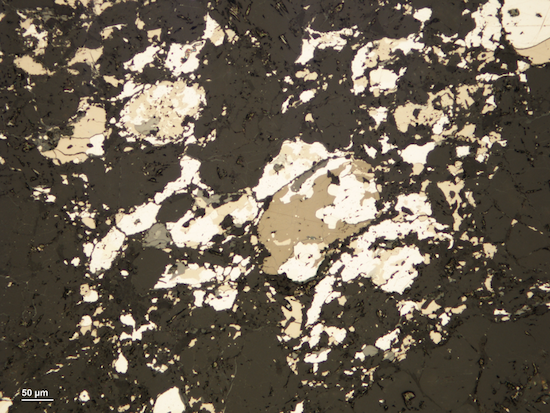 Earth & Space
Earth & Space
A snapshot from the early Earth
Research into understanding how the Earth acquired its volatile elements suggests that primitive materials that formed early in the Solar System had a limited range in halogen compositions.

The physical and chemical evolution of planets relies on certain volatile elements, such as Hydrogen (H), Carbon (C), and Nitrogen (N). For instance, on Earth volatile elements influence magma chemistry, volcanism and the evolution of our atmosphere and climate. Perhaps most important, the presence of volatile elements is critical to the overall habitability potential of any planet. For these reasons, scientists have long been interested in understanding some fundamental questions as to how and when the Earth acquired its volatile elements and how volatiles are currently distributed between Earth's geochemical reservoirs, like the atmosphere and mantle. This research is not restricted to Earth alone, and there has been significant research into understanding the same questions for other planetary bodies, such as the Moon and Mars.
In order to understand the source of Earth's volatiles, we need to not only sample Earth's current inventory but also look to the past and try to characterize the planet's likely building blocks. What materials made Earth, and what do their volatile inventories look like? To do this, we can look at different meteorites. Meteorites fall to Earth as remnants of other planets (like Mars), the Moon, and asteroid "parent bodies" offer scientists a cross section of planetary compositions to study. In this study, we focused on primitive chondrites, which are meteorites that have undergone only minor to moderate chemical processing, such as being heated or aqueously altered by fluids. These samples have never been melted and offer a snapshot of primitive chemical compositions from the early Solar System.
We chose a wide range of primitive meteorites from different parent bodies with different physical and chemical attributes and measured a particular group of volatile elements, the halogens (chlorine, bromine and iodine). Our unique methodology enables the measurement of very small samples (which is often necessary when working with meteorites) with very low concentrations of these volatile elements. Halogens are very useful geochemical tracers, as they are present in low abundances and they track with water, allowing us to study the fate of Earth's volatile inventory. Halogens are also important constituents of salts and a balanced salt budget is critical to the development of life on Earth. Prior to this research, it was thought that the Earth would have needed to lose a significant amount of its halogen budget (chlorine in particular) in order for life to develop because the meteorites that may represent material that formed Earth had a relatively high chlorine concentration. One popular proposed method for doing so is impact-driven removal of a chlorine-rich early crust on Earth. Although the mechanism is feasible, it is hard to envisage because it is difficult to exclusively lose chlorine from early Earth without affecting other elements of similar volatility, like potassium or sodium.
We measured the halogen concentrations in over twenty small meteorite samples. We found that across very different meteorite types and chemical compositions, the ratios of halogens were remarkably similar, and furthermore very similar to the ratios preserved in the silicate Earth today. These ratios are also very different from other planetary materials, like pieces of the Moon and Mars. We also found that the absolute halogen concentrations were very low - a different result to previous studies. These results show that the Earth formed from materials that had much lower halogen abundances than previously thought, which means that early Earth didn't need to exclusively lose chlorine, it simply formed from materials with low chlorine to begin with. This simple explanation means that early Earth didn't require impact-driven removal of halogens and places the halogens squarely in line with elements of similar volatility. Our results also have implications for where and how Earth's volatiles were delivered - that a significant portion of Earth's halogen budget was retained from initial accretion.
Original Article:
P. L. Clay et al., Halogens in chondritic meteorites and terrestrial accretion. Nature 551, 614-618 (2017)Next read: A neighborhood in space: finding the Moon’s age to understand Earth’s evolution by Maxime Maurice
Edited by:
Massimo Caine , Founder and Director
We thought you might like
The fragrance of plants: how their perfume pervades the air
Apr 18, 2018 in Plant Biology | 3.5 min read by Joshua Widhalm , Funmilayo Adebesin , Natalia DudarevaThunderstruck! A quasicrystal made by lightning
Sep 11, 2023 in Earth & Space | 3.5 min read by Luca BindiA four-legged ancestor led the way for early whales dispersal
Sep 16, 2019 in Evolution & Behaviour | 4 min read by Olivier LambertWhat space dust could tell us about Earth’s past
Jan 5, 2021 in Earth & Space | 3 min read by Rebecca PayneMore from Earth & Space
Discovery of the first radiation belt beyond the Solar System
Jan 27, 2025 in Earth & Space | 3.5 min read by Juan Bautista Climent OliverOne million (paper) satellites
Jan 24, 2025 in Earth & Space | 3 min read by Ewan Wright , Andrew FalleVolcanic Ash: A Nutrient Boost for Reef-Building Corals
Sep 18, 2024 in Earth & Space | 4 min read by Frank Förster , Tom SheldrakeAmmonia Energy: A Call for Environmental Awareness
Aug 29, 2024 in Earth & Space | 3.5 min read by Matteo Bertagni , Robert Socolow , Amilcare PorporatoLikely increase in coral thermal tolerance at a Pacific archipelago
Dec 29, 2023 in Earth & Space | 3 min read by Liam LachsEditor's picks
Trending now
Popular topics


